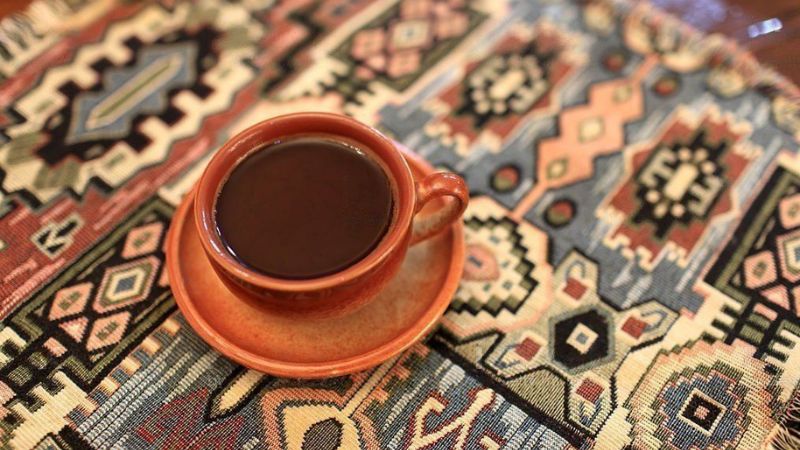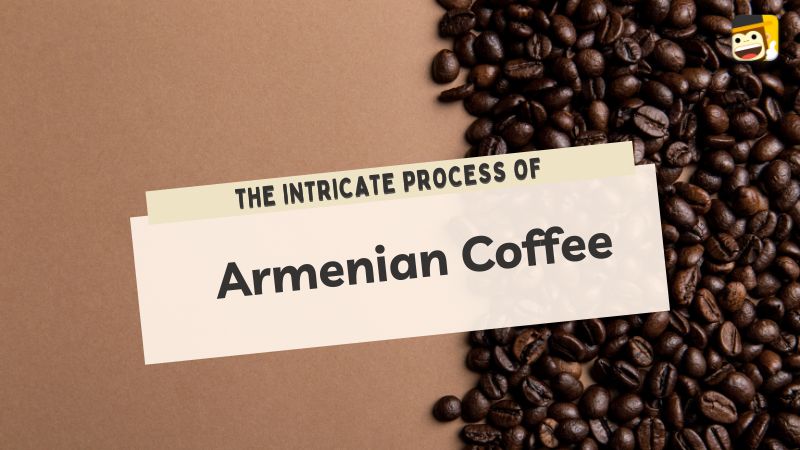Armenian coffee, or սուրճ ‘(pronounced ‘sorsch’) as it’s called in Armenian, is an exquisitely flavorful, strong brew ideal for even the pickiest coffee connoisseurs. The art of producing an authentic Armenian cup of ԳAVAT (pronounced ‘Kavat’) has been perfected across generations of Armenians.
Imagine walking through the colorful streets of Yerevan, the stunning mountain range in the background, when you suddenly get a waft of the most heavenly smell. Nestled in the streets of Armenia are small stalls selling freshly roasted coffee beans daily.
Armenians drink coffee multiple times a day and have perfected their technique over the years. It takes discipline, time, and concentration to craft this delicacy. Keep reading to learn more about the origins and process of one of Armenia’s most beloved and sacred cultural traditions: drinking & enjoying a finely made cup of coffee.

The Origins: What Exactly Is Armenian Coffee?
The origins of coffee in Armenia date back to the Ottoman Empire. Coffee came from Arabia (today’s Turkey) and then to Armenia.
Interestingly enough, Armenian merchants loved coffee so much that they opened the first ever coffee houses in Europe. During this time, espresso was the primary seller, and it was a time for social gatherings and shared community.
Even today, entertaining guests with coffee is integral to Armenian culture. An Armenian friend or relative will offer you a steaming cup when you visit their home. It is a chance to relax and have a good conversation over a delicious, traditional Armenian brew.

How To Make Armenian Coffee
The basic technique of brewing coffee is the same in most Middle East countries but varies from country to country. In Armenia, this traditional technique is over 1000 years old! It starts by grinding coffee beans into a finely ground, powdery texture.
*Side note: Armenia cannot grow a lot of their coffee beans, so most are imported from Columbia.
The coffee powder is mixed directly with carefully measured water and sugar, then heated over a direct flame in a special mocha pot called a ‘jazzve’ until the crema rises. If it over-boils, the crema will dissipate, and the taste will be off. So, you must get that sweet spot where it boils, but not too much.
Important note: Some people add cardamom capsules to the cups first, then fill the coffee on top. The pods add a strong, floral aroma to the drink that is unique to Armenian coffee.

The Importance Of The Jazzve: Traditional Armenian Coffee Pot
The traditional Armenian coffee pot called the ‘jazzve’ is integral in the process. It is so crucial to the technique that one of the biggest coffee chains in the capital city of Yerevan’s name is ‘Jazzve,’ after the vessel used to make the coffee.
The ‘jazzve’ are beautiful, handcrafted coffee pots with a unique U shape (usually made of copper) that add a sort of magic touch while creating the perfect cup of coffee. These types of Armenian coffee pots are sold in the Vernissage, the largest open-air market in the capital city of Yerevan.
The process of brewing and serving Armenian coffee, especially using a ‘jazzve,’ is a great tradition and an integral part of sharing their culture and love.
Keen to pair your delicious cup of Armenian coffee with a sweet dessert? Check out 15 Crazy Yummy Armenian Desserts to satisfy your coffee kick and sweet tooth.

Desired Taste, Appearance, And Aroma Of Armenian Coffee
Armenian coffee has a strong taste, similar to espresso. Middle Eastern coffee is traditionally served in small cups with a strong punch, which rings true for Armenian coffee.
When the coffee is ready, it is immediately served in a tiny 3 oz cup. The bold, full-bodied taste is indescribable, and any true coffee lover will tell the difference in quality.
There is no bitter aftertaste with Armenian coffee, and if you use sugar, the flavor is more evenly distributed.
If the coffee is prepared correctly, there should be a thick layer of rich cream on top of the cup. The cream is formed when the coffee is stirred while starting to boil, and remains in the cup, even after being transferred from the ‘jazzve’.
The aroma is perhaps one of the more famous attributes of Armenian coffee. If you choose to use cardamom capsules, the coffee will have a refreshing, floral scent.
The consistency is thicker than most other types of coffee. Because Armenian coffee is unfiltered, one must wait for the grounds to fall to the bottom before drinking (this is what leaves the residue for the coffee reading).

Reading Your Fortune: Armenian Tradition Of Coffee Reading
What to do after you finish your Armenian coffee? Instead of abandoning your cup, why not get a traditional coffee reading?
Though the centuries-old coffee reading tradition isn’t as popular as it once was, people today still wish to carry on the tradition and have their fortunes read through their coffee cup.
Before you wash your cup, rotate it away from the saucer and let the residue drip down the sides for a few minutes. This triggers the creation of various shapes and symbols, aka the foretelling of your future!
The fortune readers are usually older folks (like an Armenian grandmother) with a critical eye and well-seasoned lives of their own. They will often find important information in the remnants of the cup, like a critical date in the drinker’s life or a specific animal symbol that has meaning to them.
For example, a horse is a desire, while a chicken means you will soon hear an exciting piece of news. Most often, the reading will uncover future adventures & misfortunes.
Armenian Vocabulary About Coffee
After learning so much about the intricate process & history of Armenian coffee, you now need the language skills to make the information applicable on your visit to Armenia! So get comfy and grab a notebook & pen with your steaming cup of coffee to learn some vocabulary in Armenian.
In Conclusion
As Armenia is a transcontinental nation (of both Europe and the Middle East), you see influences of both in the way they brew and enjoy their coffee.
The sacred coffee culture in Armenia is fascinating and beautiful. The ritual of preparing Armenian coffee brings families and friends together at home. In Armenia, coffee is so much more than just the taste (although the taste is delicious!)
If you’re ever traveling in Armenia, visit one of the hundreds of coffee shops and check out the careful preparation and sacred traditions yourself – the unique experience will leave you a more knowledgeable and cultured individual.

Learn Armenian With Ling
If you enjoyed learning about Armenia’s coffee culture, you probably want to learn more about their language!
The Ling App is a language-learning app that provides lessons and courses in over sixty languages, with Armenian being one of them. It is a reliable method to improve your skills, especially with this lesser-known language. Download it on the App Store and Play Store for free today!






















